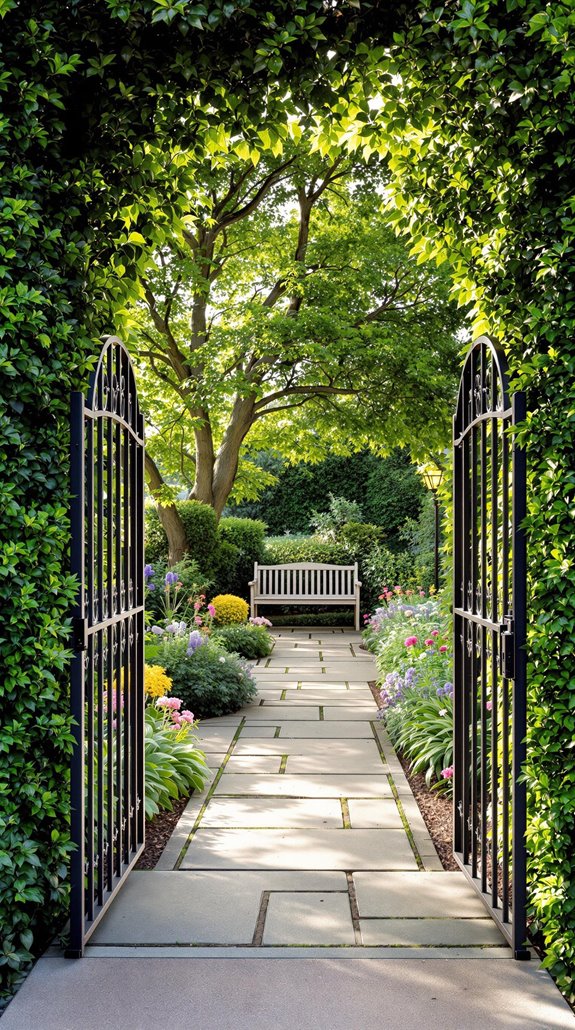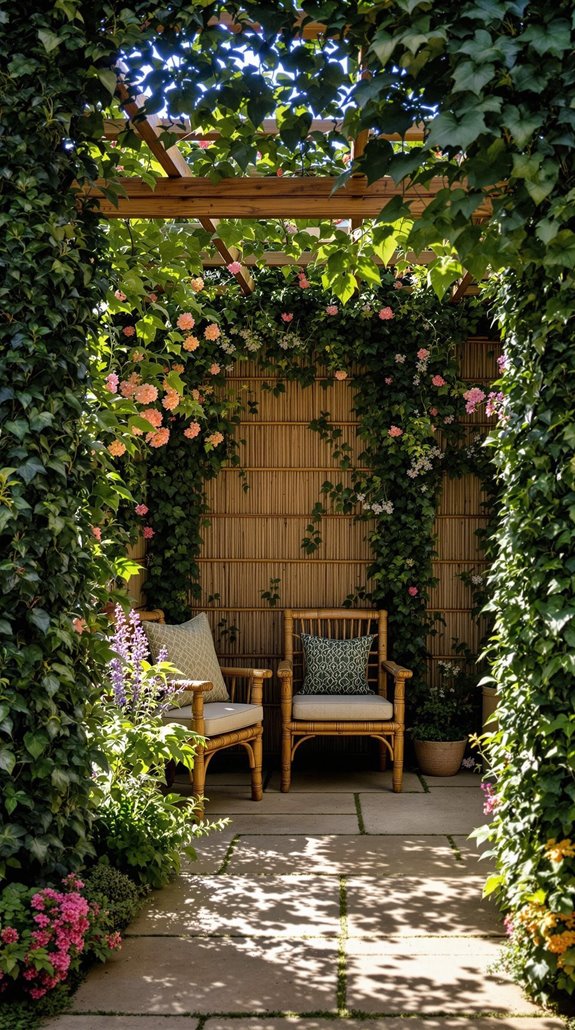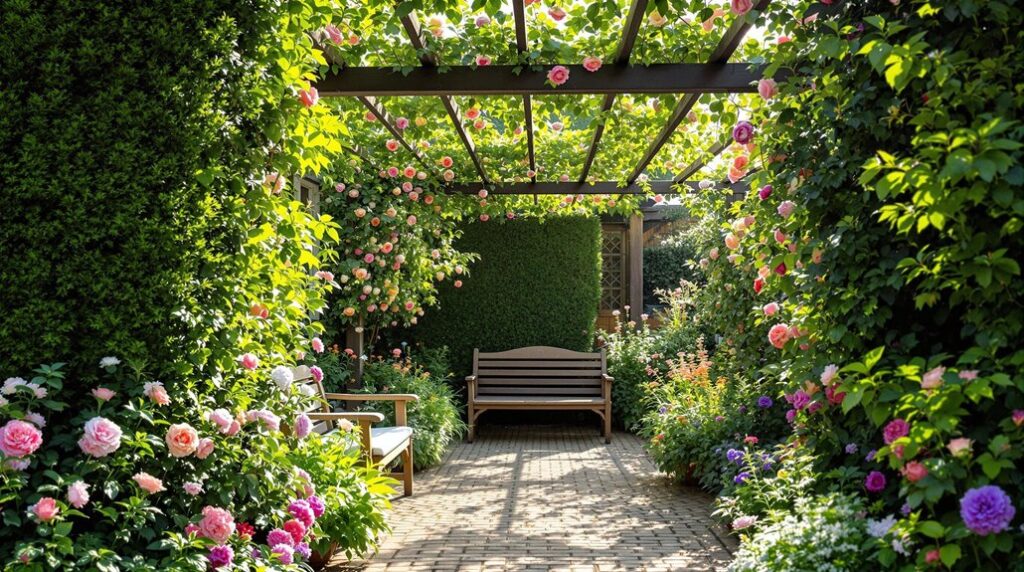I’ve spent years helping homeowners navigate UK privacy laws, and here’s what I’ve learned: creating a secluded front garden isn’t just about throwing up the tallest fence you can find. There are specific height restrictions, planning regulations, and neighborly considerations that’ll either make or break your privacy project. The good news? I’ve discovered several clever workarounds that’ll give you the seclusion you’re after without landing you in hot water with the council.
Key Takeaways
- Install 1-metre fences with climbing plants like ivy or clematis to maximize privacy while complying with UK planning laws.
- Plant evergreen hedging such as English Laurel or Yew for year-round dense screening and natural boundary definition.
- Use raised planters under 1 metre height with tall bamboo or shrubs to create elevated privacy without permits.
- Combine horizontal panel fencing with decorative trellises and fast-growing plants for immediate and long-term screening solutions.
- Position pergolas and strategic lighting to block sightlines from neighboring windows while maintaining garden accessibility and security.
Understanding UK Privacy Laws and Height Restrictions for Front Gardens
When planning privacy solutions for your front garden, you’ll need to navigate UK regulations that strictly control fence heights based on location. I’ve found that understanding these rules saves you from costly mistakes and neighbor disputes.
The key restriction is simple: if your fence sits adjacent to a public highway, footpath, or driveway, you’re limited to 1 metre maximum height without planning permission. However, if your fence doesn’t border these areas, you can build up to 2 metres. Ground level differences between properties can significantly affect how fence height is assessed, so it’s important to consider land level differences when planning your installation. Additionally, adhering to approved planning permissions is crucial to avoid heavy fines that could arise from unauthorized changes.
Pay special attention to driveway visibility requirements – that 1 metre limit guarantees safe vehicle access. Local councils often impose additional restrictions, especially in conservation areas or around listed buildings. I always recommend checking with your local planning authority first, as non-compliance can lead to enforcement action requiring expensive alterations.
Creative Screening Solutions That Comply With Planning Regulations
Now that you’re familiar with the height restrictions, let’s explore practical screening solutions that work within these legal limits.
I’ve found privacy plants are the most effective approach for natural screening. Choose evergreen shrubs and fast-growing bamboo with root barriers for year-round coverage. Layer different heights to create dense, compliant screens. Additionally, using traditional plaster can enhance the visual appeal of garden structures that incorporate plants.
For structure-based solutions, install trellises under 1m with climbing plants like ivy or clematis. Use permeable materials such as lattice that allow light flow while maintaining privacy.
Combine approaches by pairing compliant 1m fences with plants growing above them. This gives you height without violating regulations since the structure meets requirements.
Build raised planters under 1m to elevate plants for added screening height. Consider decorative screens using laser-cut metal or woven materials that complement your property’s aesthetic.
Always ensure your fencing materials meet British Standards for durability and safety compliance before installation.
Balancing Security and Privacy in Front Garden Design

While privacy screens offer seclusion, they can inadvertently create security vulnerabilities if not carefully planned. I’ll help you strike the right balance between privacy and protection. A well-designed garden can also enhance your property value significantly.
Keep all screening plants under 1m height near windows and paths—this maintains your seclusion while eliminating hiding spots for intruders. I recommend layering thorny shrubs like pyracantha beneath windows, then placing taller screening plants behind them. This creates depth without compromising visibility.
Choose open-design fencing with slats or trellis rather than solid panels. You’ll maintain boundary definition while preserving sightlines to the street. Space ornamental grasses 60cm apart—they’ll screen your space while allowing visibility through their stems.
Add gravel paths for natural intrusion alerts, and position motion-sensor lights 2.4m high to illuminate approaches without creating glare for neighbours. For year-round coverage, consider evergreen hedging like Yew or Thuja which maintains its screening properties even in winter months.
Natural Privacy Options: Plants, Hedges, and Living Screens
Nature’s screening solutions offer the perfect blend of privacy and beauty that transforms your front garden into a living sanctuary. I’ll help you choose plants that work hard for your space while creating the welcoming atmosphere you’re after.
For year-round coverage, I recommend English Laurel or Yew – both provide dense, evergreen screening that won’t let you down. If you’re after something more formal, Boxwood creates those crisp, tailored hedges that give your garden structure. Beech offers seasonal interest, keeping its copper leaves through winter. Additionally, incorporating drought-resistant plants like creeping thyme can enhance your garden’s resilience and aesthetic appeal.
Here’s what I’ve learned works best: plant in staggered rows for faster coverage, prepare your soil with organic matter, and choose species that’ll reach your desired height naturally. Add climbing plants on trellises for instant vertical screening while your hedges establish. These natural screens also deliver significant health benefits, improving both your mental wellbeing and air quality around your home.
Strategic Placement Techniques to Maximize Privacy Without Permits

Beyond selecting the right plants, smart positioning of privacy features can double your screening power while keeping you within legal limits. I’ll position fences at property boundaries to maximize usable space, using horizontal panels that eliminate gaps completely. For overhead privacy, I’ll situate pergolas perpendicular to neighboring windows, blocking their direct sightlines into your garden. Additionally, incorporating natural light into your design can enhance the overall ambiance while still maintaining privacy.
Strategic lighting creates privacy through misdirection. I’ll place uplights beneath trees to cast concealing shadows while positioning spotlights on garden features to draw attention away from private zones. Freestanding trellis screens work brilliantly between functional areas—no planning permission needed.
Terrain manipulation offers clever solutions too. I’ll build raised decks to elevate seating above ground-level views, or position storage units as natural buffer shields against street visibility. Garden zoning creates distinct private retreats within your front space, allowing you to designate specific areas for different activities while maintaining overall seclusion.
Conclusion
You’ve got all the tools to transform your front garden into a private sanctuary. Start with that 1-metre fence, add climbing plants for natural height, and use raised planters strategically. Remember, you don’t need permits for most of these solutions—just creativity and smart placement. Focus on evergreen screening for year-round coverage, and you’ll create the secluded oasis you’re after while staying completely compliant with UK regulations.
References
- https://www.themiddlesizedgarden.co.uk/new-directions-in-garden-privacy-screens/
- https://www.ons.gov.uk/economy/environmentalaccounts/articles/oneineightbritishhouseholdshasnogarden/2020-05-14
- https://tmconstruct.co.uk/garden-privacy-solutions-overlooking-neighbours/
- https://www.cladcodecking.co.uk/blog/post/uk-gardening-statistics
- https://www.met.police.uk/cp/crime-prevention/protect-home-crime/protecting-garden-to-safeguard-your-home/
- https://ukconstructionblog.co.uk/2024/10/02/front-garden-fence-height-regulations-uk/
- https://www.goodbuilds.co.uk/help-and-advice/project-guides/garden-outdoors/how-to-make-your-garden-feel-more-private/
- https://shedsandfence.co.uk/how-high-can-a-garden-fence-be-uk/
- https://www.idealhome.co.uk/garden/landscaping/front-garden-privacy-ideas
- https://www.countryliving.com/uk/homes-interiors/gardens/a64030210/garden-fences-uk-rules/


